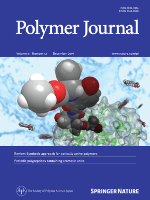
POLYMER JOURNAL
Scope & Guideline
Unveiling the Potential of Polymer Materials
Introduction
Aims and Scopes
- Polymer Synthesis and Characterization:
The journal publishes studies on various polymerization techniques, including radical, anionic, and cationic polymerizations, as well as innovative methods for synthesizing and characterizing new polymeric materials. - Biopolymer Applications:
Research on biopolymers is a core focus, highlighting their use in drug delivery systems, tissue engineering, and sustainable materials, particularly in the context of medical and environmental applications. - Nanocomposite Development:
The journal covers the creation and application of polymer nanocomposites that incorporate nanoparticles to enhance mechanical, thermal, and electrical properties, addressing industrial and technological challenges. - Smart and Responsive Materials:
A significant area of research includes the development of smart materials that respond to environmental stimuli such as temperature, pH, and light, with applications in sensors, actuators, and drug delivery. - Sustainability and Green Chemistry:
The journal encourages research that promotes sustainability, including the use of bio-based feedstocks and environmentally friendly synthesis methods, as well as the recycling and reusability of polymers.
Trending and Emerging
- Biodegradable and Bio-Based Polymers:
There is a significant increase in research focused on biodegradable and bio-based polymers, driven by environmental concerns and the need for sustainable materials in various applications. - Smart Polymers and Hydrogels:
Emerging interest in smart polymers, particularly hydrogels that respond to stimuli such as temperature and pH, reflects advancements in drug delivery systems and biomedical applications. - Nanotechnology in Polymer Science:
The integration of nanotechnology into polymer research is trending, with a focus on nanocomposites that enhance the properties of traditional polymers for a range of applications, including electronics and energy storage. - Polymer-Based Drug Delivery Systems:
The development of advanced polymer-based drug delivery systems, particularly those that are responsive to environmental triggers, is gaining traction, highlighting the intersection of polymer science and medicine. - Recyclable and Reprocessable Polymers:
Research on recyclable and reprocessable polymers is on the rise, aiming to address plastic waste and promote circular economy practices within the materials science community.
Declining or Waning
- Traditional Polymerization Techniques:
Research focused solely on conventional polymer synthesis methods has decreased as newer, more efficient techniques such as RAFT and ATRP gain popularity, indicating a shift towards more advanced methodologies. - Standardization in Polymer Testing:
There is a noted decrease in papers dedicated to the standardization of testing methods for polymers, as researchers are increasingly exploring innovative applications rather than focusing on conventional testing protocols. - Basic Polymer Science Studies:
While foundational studies remain important, there has been a decrease in publications that do not directly link polymer science to practical applications, as the field shifts towards applied research with immediate relevance. - Single-Function Polymers:
The interest in polymers designed for single applications is waning, with a growing preference for multifunctional materials that can serve multiple purposes in various applications. - Non-biodegradable Polymer Studies:
As sustainability becomes a greater concern, research on non-biodegradable polymers has decreased, reflecting a shift towards biodegradable and environmentally friendly materials.
Similar Journals

ACS Polymers Au
Driving discoveries in the realm of polymers and plastics.ACS Polymers Au, published by the American Chemical Society, is an innovative open-access journal dedicated to advancing the field of polymer science. Launched in 2021, this journal offers researchers, professionals, and students a platform to publish and access high-quality research articles without the barrier of paywalls, thereby fostering greater collaboration and knowledge sharing within the scientific community. With a focus on polymers and plastics, as well as their applications in materials science and chemical engineering, ACS Polymers Au is recognized for its rigorous peer-review process and commitment to maintaining high research standards. Although currently ranked in the lower percentiles across various categories in Scopus metrics, its dynamic publication format allows for rapid dissemination of cutting-edge findings. As the journal continues to grow and evolve alongside the polymer community, it remains an invaluable resource for those aspiring to enhance their scientific understanding and contribute to the future of polymer research.
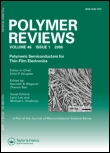
Polymer Reviews
Exploring innovations in materials chemistry.Polymer Reviews, published by Taylor & Francis Inc, is an esteemed journal dedicated to the intricate and evolving field of polymer science. With its ISSN 1558-3724 and E-ISSN 1558-3716, the journal has established a significant presence among researchers and practitioners alike, evidenced by its impressive categorization in the Q1 quartiles across multiple disciplines, including Biomedical Engineering, Materials Chemistry, and Renewable Energy. Since its inception in 2006 and continuing through 2024, Polymer Reviews has consistently aimed to advance the knowledge base of polymer applications and innovations, providing a platform for comprehensive review articles that stimulate further research and inspire practical solutions. The journal, ranking within the top percentile across several Scopus categories, underscores its impact and relevance in a rapidly developing scientific landscape. Though not an open-access journal, it remains a vital resource for those invested in the future of materials science and engineering.

JOURNAL OF POLYMER SCIENCE
Exploring the Science of Polymers: Where Innovation Meets ApplicationJOURNAL OF POLYMER SCIENCE, published by WILEY, is a premier, open-access journal dedicated to advancing the field of polymer science and its applications. With an ISSN of 2642-4150, it offers a platform for high-quality research and innovative ideas, contributing significantly to the understanding of polymaterials and their functionalities. The journal is recognized for its exceptional impact within various categories, consistently achieving Q1 rankings in Materials Chemistry, Physical and Theoretical Chemistry, and Polymers and Plastics, demonstrating its influential presence in the academic community. As of 2023, it holds a distinguished position in Scopus rankings, underscoring its relevance and rigorous peer-review process. By facilitating open access to vital research findings, the JOURNAL OF POLYMER SCIENCE plays a crucial role in fostering collaboration and knowledge transfer among researchers, professionals, and students, paving the way for innovative developments in polymer applications and materials science.
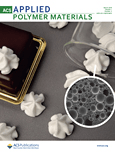
ACS Applied Polymer Materials
Unveiling Breakthroughs in Material ScienceACS Applied Polymer Materials is a prestigious journal published by the American Chemical Society, specifically tailored for the dynamic fields of Organic Chemistry, Polymers and Plastics, and Process Chemistry and Technology. With its ISSN 2637-6105, the journal has rapidly established itself within the academic community, achieving a distinguished Q1 quartile ranking across multiple categories in 2023. This places it among the top-tier journals globally, reinforcing its critical role in disseminating groundbreaking research and innovation in polymer science. The journal is known for its rigorous peer-review process and publishes high-quality articles that are pivotal for researchers, professionals, and students eager to advance knowledge in polymer materials and their applications. Positioned to cover converging themes from 2019 through 2024, ACS Applied Polymer Materials embraces a wide scope of studies, from fundamental chemistry to practical engineering applications, thereby fostering significant advancements in material science. While it offers traditional access options, the journal's impact is reflected in its impressive rankings within Scopus, indicating its relevance and influence in the chemical engineering domain. Join the global community of innovators and discover the latest insights that continue to shape the landscape of applied polymer research.

ACS Macro Letters
Advancing the Frontiers of Macromolecular ScienceACS Macro Letters, published by the American Chemical Society, is a leading journal in the fields of Inorganic Chemistry, Materials Chemistry, Organic Chemistry, and Polymers and Plastics. Established in 2012, this journal has swiftly ascended to the forefront of chemical research with an impressive reputation, as evidenced by its 2023 Scopus rankings placing it in the first quartile across multiple categories. The journal's objective is to disseminate timely and concise articles that advance the study of macromolecules and their applications, making it an essential resource for researchers, professionals, and students alike. With a focus on fostering innovation and facilitating collaboration within the chemical community, ACS Macro Letters presents a robust platform for scientists to share their groundbreaking findings. Being based in the United States, it serves as a central hub for global discourse in the chemical sciences, although it does not currently offer Open Access options. The journal's commitment to high-quality content is further underscored by its prestigious impact factor and acceptance into elite academic quartiles, signifying its influence and importance in shaping future research.
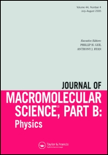
Journal of Macromolecular Science Part B-Physics
Advancing the Frontiers of Macromolecular PhysicsThe Journal of Macromolecular Science Part B-Physics, published by Taylor & Francis Inc, is a critical platform for advancing knowledge in the realms of macromolecular science and interdisciplinary research at the intersection of physics, chemistry, and materials science. With an ISSN of 0022-2348 and E-ISSN of 1525-609X, this journal has been a cornerstone of scientific discourse since its inception in 1967, continuing to offer invaluable insights and innovative findings through to 2024. The journal holds a Q3 ranking across several disciplines, including Chemistry (miscellaneous), Condensed Matter Physics, Materials Chemistry, and Polymers and Plastics, reflecting its relevance and importance within the scientific community. Although it does not support open access, the rigor of its peer-review process ensures that published articles meet the highest standards of scientific excellence. Researchers, professionals, and students alike will find the journal an essential resource for the latest trends and discoveries in macromolecular physics, aiding in both academic pursuits and practical applications in material design and analysis.
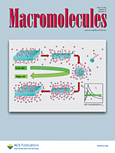
MACROMOLECULES
Exploring the Frontiers of Polymer ScienceMACROMOLECULES, published by the American Chemical Society, is a premier journal in the fields of inorganic chemistry, materials chemistry, organic chemistry, and polymers and plastics. Since its inception in 1968, this influential journal has established itself as a vital resource for researchers, professionals, and students, showcasing cutting-edge research and advancements in the study of macromolecules and high-performance polymers. With a distinguished impact factor and consistently ranking in the top quartiles (Q1) across its relevant categories, MACROMOLECULES is recognized for its high-quality publications that contribute significantly to the scientific community. The journal is accessible in both print and electronic formats, facilitating rapid dissemination of knowledge. By providing a platform for innovative studies and groundbreaking discoveries, MACROMOLECULES continues to play a crucial role in shaping the future of materials science and polymer research.
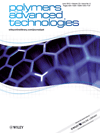
POLYMERS FOR ADVANCED TECHNOLOGIES
Transforming Ideas into Advanced Polymer SolutionsPOLYMERS FOR ADVANCED TECHNOLOGIES is a premier peer-reviewed journal published by WILEY, focusing on cutting-edge research in the field of polymers and plastics. Since its inception in 1990, the journal has established itself as a critical resource for academics and industry professionals alike, reflecting advancements and innovations in polymer science and technology. With an impressive Scopus ranking of #45 out of 161 in the Materials Science category and a 72nd percentile ranking, it ranks in the Q2 quartile for its relevance and impact within the polymers field. The journal's comprehensive scope encompasses recent developments and trends in polymer applications, synthesis, and characterization, making it essential reading for researchers looking to advance their work within this dynamic area. Researchers can submit their work in the UK, where the journal is published, and while it does not currently offer open-access options, its robust impact factor highlights the significance of the research it disseminates. Join the community of experts pushing the boundaries of polymer science by engaging with POLYMERS FOR ADVANCED TECHNOLOGIES. Continuous exploration and innovation await those who contribute to and learn from the journal’s diverse array of studies.
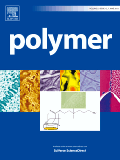
POLYMER
Elevating Knowledge in Organic and Polymer ChemistryPOLYMER, an esteemed journal published by Elsevier Science Ltd, stands at the forefront of polymer science, presenting cutting-edge research that encompasses the realms of Materials Chemistry, Organic Chemistry, and Polymers and Plastics. With a remarkable impact factor reflecting its significance in the academic community, POLYMER has been a vital resource since its inception in 1960, contributing to a converged body of knowledge through to 2024. Rated Q1 in all relevant categories as of 2023, and boasting impressive Scopus rankings, this journal not only facilitates advanced discussions in polymer synthesis, characterization, and applications but also serves as a critical platform for collaborative research among scholars, professionals, and students. While it offers content primarily via subscription, POLYMER remains dedicated to fostering innovation and excellence in the field, making it an essential read for anyone passionate about polymer science.

POLYMER SCIENCE SERIES C
Connecting Knowledge and Innovation in PolymersPOLYMER SCIENCE SERIES C is a distinguished journal published by MAIK NAUKA/INTERPERIODICA/SPRINGER, focusing on advancing research in the fields of polymer science and materials chemistry. With an ISSN of 1811-2382 and an E-ISSN of 1555-614X, this journal has been actively disseminating vital findings since its inception in 2000, aiming to converge knowledge and innovations until 2024. Operating out of the United States, it stands out with its current quartile rankings of Q3 across several categories, including Chemistry (miscellaneous), Materials Chemistry, and Polymers and Plastics, highlighting its evolving significance in the academic community. Despite its open access status, the journal attracts an engaged audience of researchers, professionals, and students, providing a platform for the publication of rigorous peer-reviewed articles that explore the intricacies of polymer synthesis, characterization, and applications. POLYMER SCIENCE SERIES C not only serves as a vital resource for keeping abreast of recent developments in polymer research but also stimulates interdisciplinary collaborations and innovative approaches in material science.